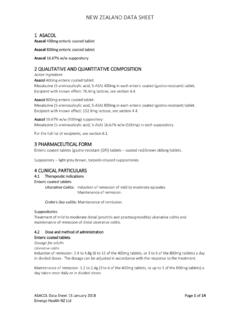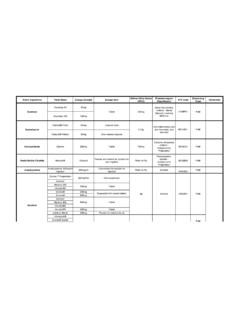Transcription of Regulatory Expectations of Presentation of …
1 Safeguarding public healthRegulatory Expectations of Presentation of Dissolution DataDavid DarlingPharmaceutical AssessorMedicines and Healthcare products Regulatory Agency (MHRA), UKSeptember 2012 Slide 2 September 2012 Content Why Use Dissolution Testing? Dissolution Method Development and Validation Dissolution Data for Marketing Authorisation Applications Dissolution Data to Support Post-Approval Changes Setting Release and Shelf Life Specification Limits for DissolutionSlide 3 September 2012 Why Use Dissolution Testing? Ultimate objective: to ensure adequate and reproducible bioavailability without need for in vivotesting need IVIVC[IVIVC covered by later presentations] More common objective: to test drug release characteristics of a formulation or batch under standard in vitroconditions Product development:formulation and process optimisation Routine QC:to demonstrate consistency of manufacture of each batch and similarity to pivotal clinical batches To support changesin manufacture, formulation, site, pack or scale-upSlide 4 September 2012 Dissolution Method Development & Validation Pharmacopoeial method, unless justified- PhEur solid dosage forms- PhEur transdermal patches- PhEur medicated chewing gum- PhEur lipophilic solid dosage forms- PhEur apparent dissolution powders & granules PhEur (= BP Appendix XII B1)- Text harmonised with USP and JP- Linked PhEur.
2 Recommendations on dissolution testing Experimental testing conditions Recommended dissolution media Qualification and validation Expression of dissolution specifications for oral dosage forms Slide 5 September 2012 Dissolution Method Development & Validation (continued) Choice of Apparatus- Depends on physicochemical characteristics of dosage form- Apparatus 1: basket capsules, tablets- Apparatus 2: paddle - tablets, capsules- Apparatus 3: reciprocating cylinder -bead-type MR dosage forms, soft capsules, suppositories, poorly-soluble drugs- Apparatus 4: flow-through cell if change of pH needed; also as Apparatus 3 Slide 6 September 2012 Dissolution Method Development & Validation (continued) Investigate pH/media and sink conditions- Drug substance solubility across physiological pH range- Sink conditions: Dissolution medium volume 3 10 x saturation Recommended media listed in PhEur - For QC testing: Discriminatory and physiologically-relevant media Water to be used only if no pH influence on dissolution characteristics If drug poorly aqueous soluble, surfactant ( SLS) is permissible (lowest concentration to obtain sink conditions).
3 Justify alternative additives ( enzymes). Avoid organic solvents! Investigate rotation speed- speed discrimination- Too slow may lead to variable results (poorer hydrodynamics, coning)- Apparatus 1: basket 50 75 100 rpm (BP prefers 100 rpm)- Apparatus 2: paddle 50 75 100 rpm (BP prefers 50 rpm)- Apparatus 3: reciprocating cylinder dip rate- Apparatus 4: flow-through cell flow rate of mediumSlide 7 September 2012 Dissolution Method Development & Validation (continued) Demonstrating Discrimination- Above work may already demonstrate this- Formulation and/or manufacturing process development work Tablet hardness trials Varying quantity of lubricant and/or lubricant mixing timeDissolution conditions: PhEur apparatus 1 (basket), 100 rpm, 1000 ml M HClSlide 8 September 2012 Dissolution Method Development & Validation (continued) Potential Pitfalls - For generics, US FDA Dissolution Database helpful, Check if applicable to formulation and justify suitability Example 1.
4 Escitalopram oxalate tablets FDA database: Paddle, 75 rpm, N HCl, 900ml Applicant s data: > 90% dissolution after 5 minutes No discussion of why 50 rpm not investigated Escitalopram Tablets USP monograph method: 50 rpm Example 2: Lamivudine tablets FDA database: 100 & 150 mg Paddle, 50 rpm, H2O (deaerated), 900 ml FDA database: 300 mg Paddle, 75 rpm, N HCl, 900 ml FDA database may simply reflect US originator formulationSlide 9 September 2012 Dissolution Method Development & Validation (continued) Method Development Documentation:- Describe above development work- Justify conditions/method adopted- Justify any method modifications during pharmaceutical development Method Validation (ICH Q2 (R1), CPMP/ICH/381/95)..considered a method development issue, but do not forget robustness Slide 10 September 2012 Dissolution Data for Marketing Authorisation Applications (MAAs) All relevant applications (new chemical entities & generics)- Dissolution method development- Dissolution method validation- Dissolution data within batch analyses and stability studies- Description and justification of any changes (dissolution method, dissolution results, formulation, manufacture) through development- Comparison of strengths- Modified-release tablets/capsules: Effect of alcohol on dissolution rate(EMA Q&A #section6) Generics- Comparison to reference medicinal product - Biowaivers for multiple strengths - BCS biowaivers [covered by next Presentation ]Slide 11 September 2012 Dissolution Data for Generic MAAs -Comparison to reference medicinal product Advisable to investigate more than one batch of test and reference products.
5 Must include bioequivalence batches Aim: To show similar in vitrodissolution under physiologically relevant experimental pH conditions Investigate within pH 1 - (normally pH , and ) and QC media (if different) Additional investigations may be required at pH values in which the drug has minimum solubility Use 12 units to enable statistical evaluation For each condition, present comparative dissolution profiles (mean values vs. time) together with statistics (max, min, mean, RSD; f2 similarity factor if calculated; individual values)Slide 12 September 2012 Dissolution Data for Generic MAAs -Comparison to reference medicinal product (continued) Immediate Release Tablets/Capsules- > 85% dissolved within 15 minutes: test and reference similar without any further calculation- 85% dissolved within 15 minutes: calculate f2 similarity factor (see next slide) Modified Release Preparations- Calculate f2 similarity factor (see next slide)- More information later If comparative in vitro dissolution results of biobatches do not reflect bioequivalence as shown in vivo,latter prevails.
6 BUT: address and justify possible reasons for discrepancy Final QC specification reflects biobatch dissolution valueSlide 13 September 2012 Similarity Factor (f2)Defined as:f2= {[1+(1/n) t=1n(Rt-Tt)2] }n is the number of time pointsRtis the mean % drug dissolved for the current formulationTtis the mean % drug dissolved for the changed formulation Minimum of 3 time points each of 12 individual values Not more than one mean value of >85% dissolved Relative standard deviation or C of V to be <20% for the 1sttime point and <10% from 2ndto last time point An f2value of 50-100 suggests similar dissolution profiles Alternatively, can use model-dependent or model-independent methods (to be justified & validated)Slide 14 September 2012 Similarity Factor (f2) Prolonged Release Preparations Minimum of 3 time points, but may be prudent to do more- Particularly important if desired release profile not uniform( immediate release outer coat and prolonged release core) If only 3 time points: expected to mirror final specification time points (20-30% (dose dumping), 50% (defines profile), >80%) More time points = confidence of for once daily preparations (1, 2, 4, 8, 12, 16, 20 & 24 hours)Slide 15 September 2012 Dissolution Data for Generic MAAs Comparison to reference medicinal product: Gastro-resistant preparations Compare dissolution profiles at PhEur conditions (2 hrs, pH 45 min pH ) and at more neutral pHs (2-5) Hence, at least two dissolution tests in two steps: 2 hrs pH ( fasted state ) 45 min pH higher initial pH ( fed state ), 2 hrs pH 45 min pH Initial step (pH or ): 10% dissolved Second step: Comparison of dissolution profiles to be performed even if > 85% before 15 min.
7 Hence, tight sampling schedule recommended as profile comparison ( f2 calculation) PKWP Q&A EMA/618604/2008 16 September 2012 Dissolution Data for Generic MAAs -Biowaivers for multiple strengths: Prerequisites Manufactured by same manufacturing process Compositions qualitatively same, quantitatively proportional- ratio between weight of each excipient to active(s) same- Immediate release products: coating components, capsule shell, colour agents and flavours not required to follow this rule If deviation from quantitatively proportional, still considered fulfilled if i) and either ii) or iii) below apply to strength used in biostudy and strength(s) for of active substance < 5% of tablet core / capsule content weightii. weights of different tablet core / capsule content excipients are the same and only active substance weight changediii. weight of a filler is changed to account for change in amount of active substance. Amounts of other tablet core / capsule content excipients should be the same.
8 Linear pharmacokinetics(Non-linear: See guideline CPMP/EWP/QWP/1401/98 Rev. 1/ Corr)Slide 17 September 2012 Dissolution Data for Generic MAAs -Biowaivers for multiple strengths: Investigations Investigate dissolution at same conditions as above ( as performed for test and reference biostudy batches) Demonstrate similarity at all conditions between additional strengths and strength ( batch) in > 85% dissolved 15 min. - > 85% dissolved 30 min (but not 15 min), 3 time points: 1st < 15 min, 2nd at 15 min and 3rd when release close to 85%; calculate similarity factor (f2 or other justified) At pH values where sink conditions not achievable for all strengths, dissolution may differ between strengths. Demonstrate drug substance not formulation related by comparing respective strength of reference product. - In addition, similar profiles at same dose ( two tablets of 5 mg versus one tablet of 10 mg) could be 18 September 2012 Dissolution Data for Generic MAAs -BCS biowaivers Covered by next presentationSlide 19 September 2012 Dissolution Data for Generic MAAs Post authorisation requirements (if not in submission)- Comparative dissolution profile testing on first three production batches batch cannot be marketed until comparative dissolution profile testing Results to be provided at Competent Authority s request, or if dissolution profiles not similar, together with proposed action to be taken020406080100510153045 Time (minutes)
9 % Drug ReleasedReference ProductTest Product Production Batch 1 Test Product Production Batch 2 Test Product Production Batch 3 Slide 20 September 2012 Dissolution Data for MAAs Potential Pitfalls Record dissolution conditions on all documentation- Development over years, but personnel change or confusion on inter-departmental transfer- Same pH but different results due to non-documented changes presence of surfactant, change in agitation speed or buffer composition- Example: Dissolution results for clinical batch presented in pharmaceutical development section (mean 98% (n=6), min 97%, max 99%) batch analysis section (mean 86% (n=6), min 74%, max 94%) (Narrow therapeutic index drug, explanation currently awaited.) If reference = tablet, but generic = capsule (or ), paddle data at xrpm cannot be assumed to be equivalent to basket data at same speed (different hydrodynamics)Slide 21 September 2012 Dissolution Data for MAAs Potential Pitfalls (continued) Check consistency of data, consistency of story and therapeutic relevance- Example 1.
10 18 month batch stability results very consistent: n=6; min 100%, max 103%; yet 6 months: 66%, 77%, 79%, 81%, 88%, 103% Specification set at 60% (Q) at 45 min simply to meet results? Any account taken of nature of drug (narrow therapeutic index, anti-epileptic)? Any comment on inconsistencies between data sets? Any cross-reference to development work findings ( almost complete release at 30 min ; test biobatch 103 107% at 30 min)? Any relevance of USP monograph limit of 85% (Q) in 30 min? Slide 22 September 2012 Dissolution Data for MAAs Potential Pitfalls (continued) Check consistency of data, consistency of story and therapeutic relevance(continued)- Example 2. Innovator 600mg & 800mg: 100% dissolution, 45 min; Test 600mg biobatch 63%, 45 min Lab scale test 600mg, 98% dissolution after 45 min What caused change? Scale-up issues? 800mg test biobatch (common blend) showed little difference on scale-up. Non-homogeneous blend (one strength made first)?




